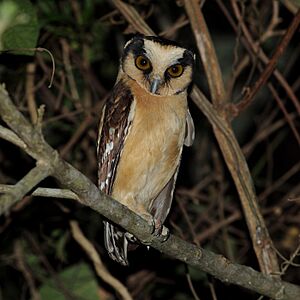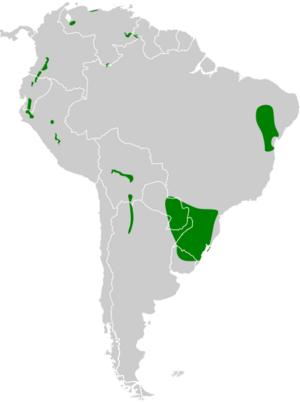Buff-fronted owl facts for kids
Quick facts for kids Buff-fronted owl |
|
|---|---|
 |
|
| Buff-fronted Owl at Dourado, São Paulo State, Brazil | |
| Conservation status | |
| Scientific classification | |
| Genus: |
Aegolius
|
| Species: |
harrisii
|
 |
|
The buff-fronted owl (Aegolius harrisii) is a small owl. You can find it in many different parts of South America. It lives in almost every country there, except for French Guiana and Suriname.
Contents
About the Buff-fronted Owl
An American bird expert named John Cassin first described this owl in 1849. He gave it the scientific name Nyctale harrisii. The name harrisii honors another American bird expert, Edward Harris.
The buff-fronted owl is the only type of Aegolius owl living in South America. Its closest relative is the northern saw-whet owl. That owl lives in Canada and the U.S. There are three types, or subspecies, of the buff-fronted owl. They are A. h. harrisii, A. h. dabbenei, and A. h. iheringi. Some scientists think A. h. iheringi might even be its own separate species.
What Does It Look Like?
This owl is about 19 to 21 cm (7.5 to 8.3 in) long. It weighs between 104 to 155 g (3.7 to 5.5 oz). It has a compact body and a short tail. Its head is large and blocky, and it does not have ear tufts.
Its face is buff-colored with a black border. It also has special black patches above its greenish-yellow eyes. The main type of buff-fronted owl has a yellowish-buff forehead and back of its neck. The rest of its head and upper body are chocolate brown. Its tail is blackish with two white bars and a white tip. The chin has a small brown patch. The rest of its belly and chest are yellowish-buff.
One subspecies, A. h. dabbenei, has darker upper parts. Its underparts have a cinnamon color. Another subspecies, A. h. iheringi, is also darker on top. Its underparts are a deeper orange color.
Where Does It Live?
The main type of buff-fronted owl lives in the Andes mountains. You can find it from Venezuela down to southern Peru. The A. h. iheringi subspecies lives in Bolivia, Paraguay, and eastern Brazil. It also lives in southern Brazil, northeastern Argentina, and northeastern Paraguay.
The A. h. dabbenei subspecies is found in northwestern Argentina. Owls seen in western Bolivia might also be this type. Scientists are not sure which subspecies lives on the tepuis (flat-topped mountains) in southern Venezuela and Guyana.
This owl lives in many different places. These include open, humid forests and dry forests. It also likes forest edges and subtropical rainforests. Sometimes, it lives in areas changed by humans, like places with fruit trees and palms. In the Andes, it lives at high elevations, from 1,500 and 3,800 m (4,900 and 12,500 ft). In other areas, it lives lower, around 600 and 1,000 m (2,000 and 3,300 ft).
How It Lives
What It Eats
Scientists have not studied much about how the buff-fronted owl hunts. They also don't know much about its diet. However, it has been seen eating insects, small rodents, and other small animals. It also eats birds.
Nesting Habits
We know very little about how the buff-fronted owl breeds. One nest was found in Brazil in March. It had three eggs. The nest was in a dead palm tree. It looked like an old nest that parrots had used. Another nest was found inside a hollow tree.
Its Call
The male buff-fronted owl's song is a fast, wavering trill. It sounds like "frurururururururu". Young owls that are still being cared for make a "hissing, raspy 'cheet'" sound. This is their begging call.
Is It Endangered?
The IUCN (International Union for Conservation of Nature) first thought this owl was "Near Threatened." But in 2004, they changed its status. Now, it is considered of "Least Concern." This means it is not currently at high risk of extinction.
People generally think this owl is rare. However, it might just be hard to spot. We don't know how many buff-fronted owls there are. But their population is believed to be stable.


